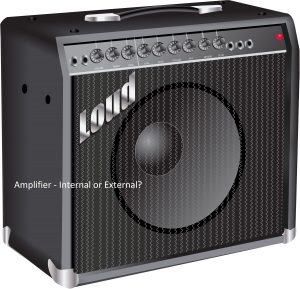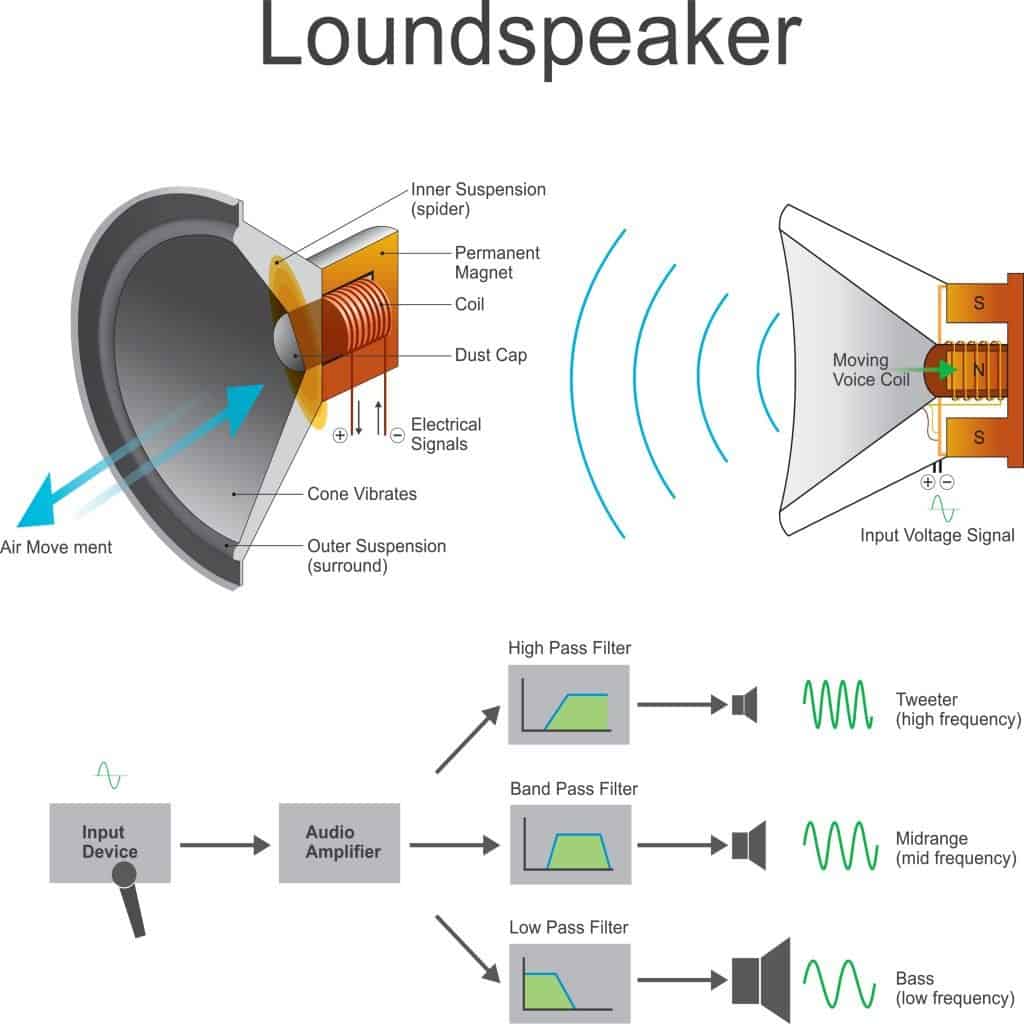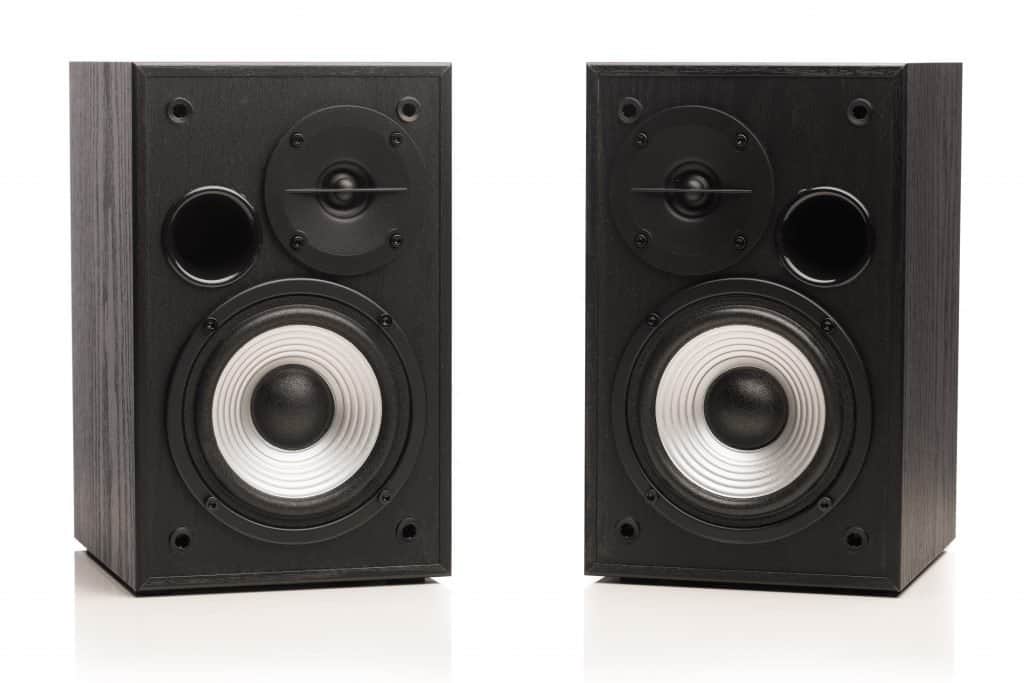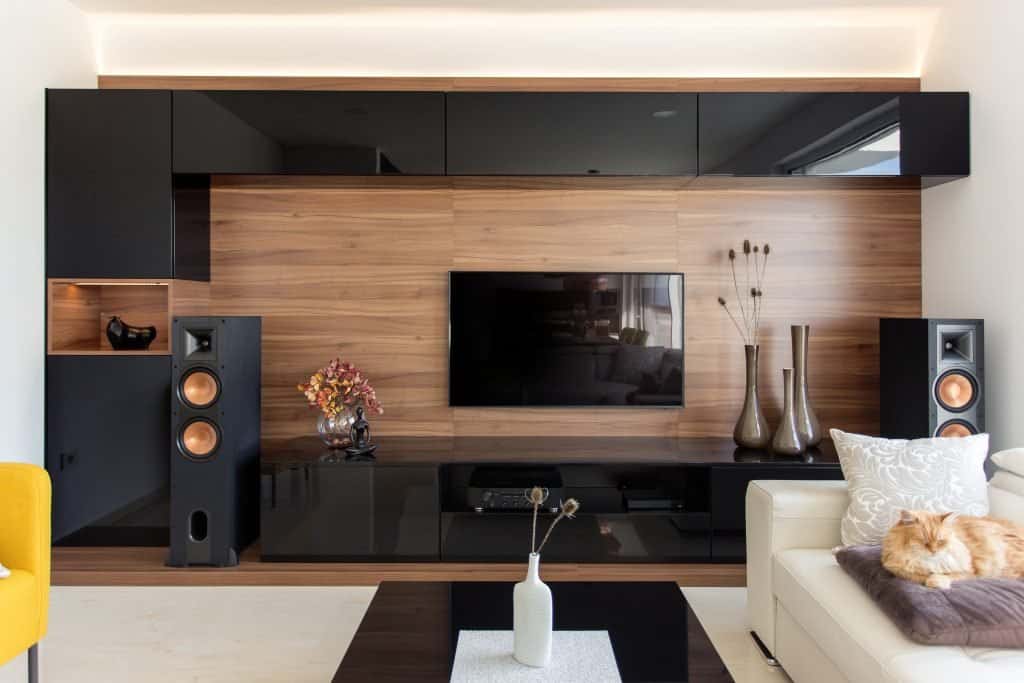In 1972 The Guinness Book of World records declared the rock band Deep Purple to be the loudest band on earth when the sound at their concert at the Rainbow Theatre reached an ear-shredding 117dB, only slightly less than that of a jet fighter on take-off.
To achieve this, they used a 10,000 watt PA system that rendered three members of the audience unconscious during the show.

It’s unlikely that in 1876 when Alexander Graham Bell patented his electric loudspeaker, he could have imagined just how loudspeakers would become. In fact, it was almost a hundred years later that JBL developed the first truly active speaker, and not until 1925 that the modern speaker was born.
Nowadays, we are aware of the damage extremely loud sounds can have on hearing, so concerts have become quieter. The active vs passive speakers debate, however, continues to rage as loud as ever among audiophiles.
So, which is better?
Before you can decide, you need to understand how speakers work and the difference between active and passive speakers.
Contents
How do speakers work?
A speaker converts electrical energy into mechanical energy. An electrical current sent through a coil converts it into an electromagnet. The coil is then alternatively repelled and attracted by a permanent magnet attached to the speaker. As the coil shunts back and forth, it moves the air, creating sound waves.

What are active and passive speakers?
Graham Bell’s first speaker had no electric components at all. Instead, a horn amplified the sound mechanically. Oliver Lodge invented the first dynamic speaker using a moving coil in 1898, and this was the forerunner of passive speakers. The first active speakers weren’t launched on the market until 1925.
How a passive speaker works
A passive speaker is unpowered. It gets its power from a separate amp via a cable. The usual progression is this:
Sound source –> Pre-Amplifier (abbreviated to ‘preamp’) –> Power Amplifier (abbreviated to ‘amplifier’ or simply ‘amp’) –> Crossover –> Speaker
Sound Source: This can be many things including a
- music streamer
- CD player
- Blu-Ray player
- phone/computer
- instrument
Preamp: This allows you to choose which source you want the sound to come from and at what volume.
Amplifier: This takes the signal from the preamp and increases it so it can power the speaker.
Crossover: This splits the signal from the amplifier and sends it to the different ‘drivers’ of the speaker. There can be several drivers in one loudspeaker. Each driver is, in fact, a single speaker. Often in one loudspeaker, you find a woofer, midrange, and tweeter, which means the crossover will split your signal three ways. If you only have a midrange and tweeter, it would split it two ways.
Speaker: The speaker can either be a single driver or, as above, can contain several drivers in one unit.
How an active speaker works
An active speaker has an internal crossover and is powered by an internal amp, so it doesn’t need an external power source like a passive speaker. The usual progression is, therefore:
Power Source –> Preamp –> Crossover –> Amplifier –> Speaker
In fact, in a powered speaker, there is usually one amplifier per driver.
Are powered speakers the same as active speakers?
The short answer is no.
The long answer is active and powered speakers are both powered. However, all active speakers may be powered, but not all powered speakers are active. Some powered speakers have the same signal progression as a passive speaker, but the preamp and power amplifier are both hidden in the unit, giving the impression of an active speaker.

Active vs. passive speakers: pros and cons
Passive speaker pros
- There are often fewer connections as you only need to plug the speaker into an amp.
- There is no need for an external power supply.
- They are usually lighter, so are easier to move or wall mount.
- They are easier to upgrade.
- They are usually cheaper than their active equivalent.
Passive speaker cons
- Your audio set up can take up more space as you’ll need a separate amp.
- You may end up with more wiring, as each passive speaker will need to be connected to an amp.
- There is more possibility of interference.
Active speaker pros
- Typically there is less external wiring.
- As more of the wiring is internal, it keeps interference down.
- You have no worries about matching components.
- They can be used wirelessly (Bluetooth) because devices such as phones, tablets, or laptops need to have their signal amplified before it can be heard by the human ear. Only active speakers can do this.
- They keep the signal digital for longer, which helps stop signal degradation.
- The signal goes through the crossover before the amplifier. This means the crossover doesn’t have to handle highly amped signals, so it can do its job better, introducing less loss and distortion. It also allows each line of the split signal to be amped separately (bi-amped), which means each driver will receive more power than in a passive system where some power is lost in the crossover stage.
- You can drive them harder without damage.
- They usually have better bass compared to similar-sized passive speakers.
Active speaker cons
- They are often heavier.
- They are usually more expensive. However, this is sometimes only perceived, rather than actual. A passive speaker with two drivers may only need one amp, and a pair can still be driven off one amp. An active speaker with two drivers will use two amps, one for each driver, which means a pair will use four. This is obviously more costly, but you are getting four amps doing specific tasks as opposed to one amp doing a general one, which will always give better sound.
- You can’t upgrade them easily, if at all.
- You may still need a preamp.
- Most speaker manufacturers don’t make their own amps and may use the most convenient or cheapest rather than the one that matches the speaker best.
Active vs. passive speakers: which is right for you?
Home Hi-Fi
Some home audiophiles can spend vast amounts on putting together the perfect system, while others are happy to go for a more ready-made solution.

Passive home speakers
Pros
- They are usually cheaper.
- They are easier to upgrade.
- They are lighter, so easier to move or wall mount.
Cons
- Passive speakers may involve more wiring.
Active home speakers
Pros
- They are often better sound quality.
- They do not need a separate amp.
- They can be used wirelessly (Bluetooth).
Cons
- They need a power outlet.
- They are usually heavier.
- It’s difficult, if not impossible, to upgrade them.
- They are generally more expensive.
- If the amp breaks, it’s usually not worth the expense of getting it repaired or replaced.
Active vs. passive speakers: DJ

DJs can have conflicting needs when it comes to speakers. If you are a DJ, you may be setting up and taking down your rig nightly, so want something quick and light to set up and move around. On the other hand, if you play a lot of bass-heavy music, you may need to go for something more complicated.
Passive DJ Speakers
Pros
- They are lighter to carry around.
- You don’t need to position them near a power supply.
Cons
- You need to carry a separate amp around.
- It will probably take you longer to set up as you’ll need to deal with the speakers and amps separately.
- You’ll need to make sure the amps you buy are matched to the speakers.
Active DJ speakers
Pros
- You don’t have to worry about under-or overpowering the speakers by buying the wrong amp.
- You can drive them harder than passive speakers without worrying about damaging the amp or speakers.
- An active speaker will usually give better bass.
- An active speaker will usually give a better overall sound output.
Cons
- They are heavier to carry around.
- They need a power supply.
- They are generally more expensive, but the increased cost per speaker may be offset by the savings made as you don’t need a separate amp.
Active vs. passive speakers: PA system.
PA systems vary enormously. You may be giving a talk in your local hall, or performing live in your local battle of the bands. Or even performing at a major venue.
Passive PA speakers: main speakers
Pros
- If you move your PA system around, passive speakers are lighter.
- Once your system is set up, you can alter all your speakers from the main mixer, rather than having to alter each speaker separately.
- With a passive PA speaker, it can be cheaper to upgrade. If your amp has an extra channel you’re not using, you can buy a new passive speaker and hook it up without the expense of a new amp.
- Alternatively, you can buy a better amp without having to buy another speaker.
Cons
- You need a separate amp. If you put up and take down your PA system a lot, it can be an extra hassle.
- The separate amp you’ll need will take up more space and also make setting up the PA system more time-consuming.
- Matching an amp correctly to your speaker can also be difficult. If you fail to match the correct amp to your speaker, it can result in your speaker being underpowered and weak or overpowered and destroyed.
- You can experience signal loss if you use a lot of speakers and they are too far from the amp.
Active PA speakers: main speakers
Pros
- You can connect a speaker to a power source and feed a line-level signal – your instrument or microphone – into it, and you’re good to go.
- Some active speakers include built-in mixers and equalizers.
- Modern active speakers are easy to use, so you don’t need a sound engineer unless you have a complicated or large-scale system.
- They usually give the best sound for the least hassle as the amp is matched to the speaker.
- They can be battery-powered, so you can set them up anywhere. This only applies to smaller active speakers. Very powerful units will require mains power.
- If you upgrade your speakers, you can always use the old ones as monitors.
Cons
- If it is not battery-powered, you’ll need to plug your speaker directly into a power source, which may restrict where you can place the speaker.
- They are heavier to lug around.
- It can be a pain if the amp in the speaker goes as you’ll have to get it professionally repaired or replace the unit.
Active vs. passive speakers: PA system: stage monitors
The pros and cons of active vs. passive stage monitors are much the same as for the main speakers, so I won’t repeat them here as it’s covered above.
Active vs. passive speakers: PA system: subwoofer
Passive subwoofer
Pros
- The chief advantage is that the signal is split before it reaches the subwoofer, so only the low-end signal is sent, making them better for larger venues where the sound needs to be separated out cleanly.
- They usually give a deeper, richer bass compared to active speakers of similar size.
Cons
- Again, you’ll need a separate amp that can add to the cost, weight, and size of the PA system.
Active subwoofer
Pros
- They are an all-in-one solution, so they are easier to transport and store.
- Being all-in-one, they are also easier to set up.
- They don’t need a power source which, if you’re in a venue not designed for live sound, may be scarce.
Cons
- The signal is split in the internal crossover, rather than earlier in the setup. This is inefficient compared to a passive subwoofer where only the low-end signal is sent to the unit.
- They are heavier, so harder to move around.
Active vs. passive speakers: studio monitors
For a long time most studios used passive monitors, but as active monitors have improved in terms of cost-effectiveness and quality, it has become normal to find high-end sound studios using either.
Passive studio monitors
Pros
- If you are after a very particular sound recording set up, you can put together exactly the components – crossover- amp – passive speaker – you need.
Cons
- You need more technical knowledge to match the right components mentioned above. Unlike a PA system, where you’ll mostly be concerned with whether you’re under or overpowering your speakers, with studio monitors you’ll be more concerned that you may be corrupting the sound. To monitor most music, you want your set up to color the music as little as possible.
Active studio monitors
Pros
- In a studio there is often a lot of gear that needs to fit into racks. With active monitors you’ll save space, as you won’t need another amp.
- They are easier to set up and if the manufacturer has done a good job of matching the correct components, will give accurate sound reproduction straight out of the box.
Cons
- With studio monitors, the usual advantages of active monitors in terms of weight may not apply. Once you have worked out the exact placement for your monitors, it’s unlikely you are going to be moving them around. If you are wall mounting them, however, it might be an issue depending on the size of the monitor.
- Like most passive speakers, active monitors are usually more expensive.
Active vs. passive speakers: car audio
Car audio has come a long way since drivers were happy with a radio and tape deck. Some of today’s in-car entertainment systems rival home cinemas.
Passive car audio speakers
Pros
- Your existing car speakers are probably already passive, so you can just drive and enjoy.
Cons
- Unless you drive a very high-end car, most car manufacturers don’t rank the audio system as a high-priority. They may fit more and more fancy in-car entertainment systems nowadays, but that doesn’t mean the speakers are that much better. The passive speakers supplied with your car, therefore, tend to be lackluster in performance.
Active car audio speakers
Pros
- An active system will be louder than a similar passive one – only around 60% of the amplified power actually goes to your speaker in a passive system. This is nearer 100% in an active one.
Cons
- It can be very complicated to set up. Things like the crossover point, slope, phase, and alignment may need to be carefully balanced.
- Bespoke active car audio systems can vary from pricey to OMG! I never realized how much it would cost!
Conclusion
Die-hard audiophiles will continue to argue over the merits of passive vs. active speakers for as long as speakers exist. The truth is, both passive and active speakers have their merits. The best active speakers are easily as good as the best passive speakers, the choice is down to personal preference or your needs.
Consider passive speakers if:
- You want to choose your amp to match your speaker.
- You want to have more control over where you place your speaker.
- Budgetary considerations are important.
- You want to use your speaker wirelessly (Bluetooth).
Consider active speakers if:
- Sound fidelity is the most essential factor and low total harmonic distortion and a flat frequency response is what you are looking for.
- You want maximum bass and output.
- You want to be able to drive your speaker hard without worrying about damaging it.
- You don’t want to choose your own amp.
FAQs
How does a passive speaker work?
The signal is sent through a preamp and then a crossover before going to a powered amplifier, which sends the signal to the speaker or one of the drivers in the speaker unit.
Do passive speakers need power?
No. Passive speakers are driven from a separate amp.
How does an active speaker work?
The signal is sent directly from the preamp to the speaker, which has a crossover and powered amp built-in. The signal passes through the crossover, then the amp, and finally to the speaker or one of the drivers.
Can you use active speakers as passive?
Not really. To do so, you would have to disconnect the crossover and amp and then feed the signal from an external amp straight to the speaker.
Passive vs. active speakers: which is better?
Neither is actually better. It depends on your needs. Passive speakers tend to be cheaper and lighter. Active speakers tend to be more expensive and heavier. However, they can be more convenient and more efficient.
Active vs. passive speakers: which to use?
Generally, use active speakers except for home hi-fi and specialist PA and live music venues.
What is the difference between active and passive studio monitors?
Active studio monitors contain a crossover and powered amplifier within the unit. They need a power source, mains or battery to work. Passive studio monitors need a separate powered amp to work, but do not need a power supply.
Active vs. passive speakers: which is best for editing?
If you are a fan of home editing, a pair of good monitors is essential. For the most part, active monitors are the easiest to set up and use.
Active vs. passive speakers: which is best for listening to vinyl?
Unless you are a real audiophile, passive and active speakers are great for listening to vinyl. However, turntables need a special phono preamp. Sometimes this is already built into the turntable or could be built into your speakers if they are powered.
You’ll also need a ground cable between the turntable and the phono preamp to stop hum and other noise.
What is a passive amplifier?
A passive amplifier is simply any powered amplifier used to power a passive speaker.
